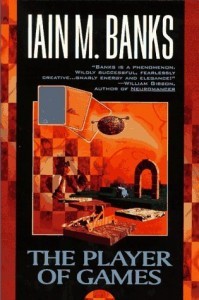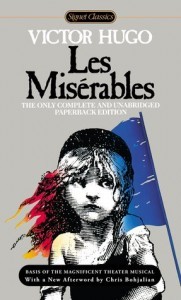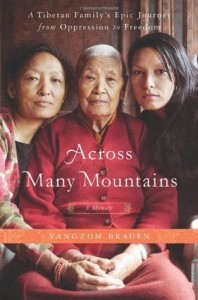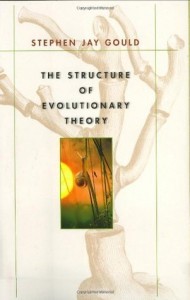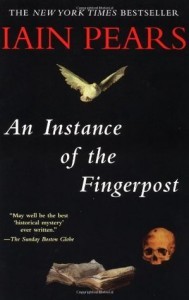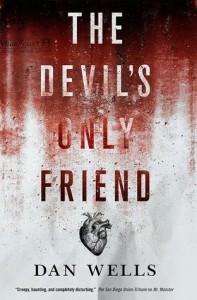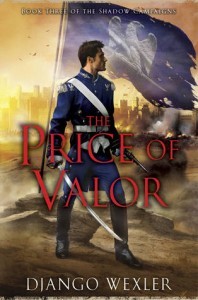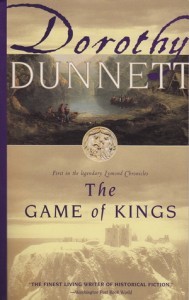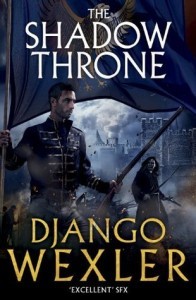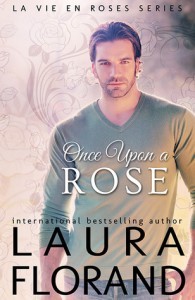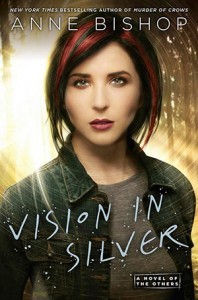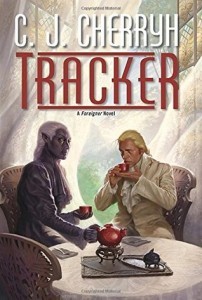Rachel Neumeier's Blog, page 334
July 7, 2015
Recent Reading: The Player of Games by Iain Banks
So, how does Iain Banks’ far-future utopia-esque universe stack up next to The Golden Age trilogy by John C Wright? And how does it compare as a story?
Taking the latter point first: Wow, did I dislike the protagonist of A PLAYER OF GAMES.
I disliked the protagonist for a long time, too; really, I never got to like him. At the beginning of the book, Gurgeh is shallow, petty, and sometimes cruel. Worse, he lacks integrity. He’s going to be used to bring down a horrible empire (and believe me, it is quite horrible), but he has to be blackmailed into participating and even then he doesn’t know what is actually going on. No one tells him the truth about The Plan because . . . well, that wasn’t clear to me. But it gives us an interesting situation where Gurgeh is extremely competent at this one thing, the game; but he is acting as a puppet of the Minds of the Culture and so he is not taking *deliberate* action to drive the underlying conflict. A protagonist who is actually a puppet is kind of . . . how can you admire this guy?
This is an interesting point from a writer’s perspective. I have seen several books lately where the protagonist did not know what was really going on until the end. Ice Cream Star comes to mind, for example, and now we have this story, completely different in practically every way but similar in this one respect. I thought withholding the truth from the protagonist – and the reader – worked a whole lot better in the former. I know exactly why Pasha lied to Ice Cream – because if he had told her what he was really trying to achieve, she would never have cooperated. But the reader is invited to really get invested in Ice Cream Star. She was very active in trying to protect other people and do the right thing all the way through, even though she had no idea what was going to happen and all her efforts crashed and burned. She feels like a real person, you get attached to her. When she sees something horrible, she is profoundly affected, sometimes to the extent of doing something really stupid, but definitely affected.
It’s different for Gurgeh. Banks holds his protagonist at a peculiar distance from the reader. Gurgeh’s affect seems strangely flat most of the time. There are times when he probably has a more extreme emotional reaction to some awful thing, but this is not apparent. To take one trivial but telling example, when the mother animal has her cubs shot in front of her and they scream and she turns back to them and gets shot and dies . . . nothing. Nothing at all. The reader is not given any insight as to Gurgeh’s reaction, if he had one. There are quite a lot of moments where Gurgeh sees something terrible and we infer he was affected, but really, there is not much evidence of it.
Also, truly, I am not clear on exactly why the Minds of the Culture did not tell Gurgeh what they hoped to achieve. I would sort have thought that telling him might have made him really commit to the goal earlier. Maybe they thought it would distract him from the game? But my impression was that well before the endgame he’d reached a state where nothing, absolutely nothing could distract him – and that the Minds who were arranging all this knew that. But Gurgeh’s ignorance of the actual plan and goal also made him a less sympathetic character, because as far as Gurgeh knows, nothing he’s doing is actually important and he’s not really in any danger, so he never gets a chance to deliberately risk his life in a noble cause. His overall character arc seemed surprisingly flat to me. I mean, at the end of the book, he still seems petty and shallow and I’m not sure he even seems very much affected by what has happened. We’re told he’s tired and so on, but he seems mostly the same when he gets home.
Anyway. I didn’t actually dislike the story. But I didn’t really like it much, either.
Now:
The writing: Just okay for me. I wouldn’t say the quality of the writing particularly stands out one way or the other. It’s not great, it’s not awful, the dialogue isn’t especially snappy, the phrasing isn’t especially clunky. It’s okay. The game itself, and the play, is described in terms that make it all seem realistically complicated. It feels right. That must have been difficult to pull off, with such a massively complicated game.
The setting: Nothing like as ornate as Wright’s. Much more familiar and for that reason, perhaps, less believable. People really haven’t changed all that much over the past tens of thousands of years; your typical experience of life hasn’t necessarily changed all that much. Sure, everybody is stupendously wealthy because of essentially unlimited resources, but people carry terminals that feel a lot like smartphones; people live in orbitals that seem indistinguishable from worlds; people have redesigned their biology but mostly not in ways you’d notice. After Wright’s trilogy, this seemed rather unbelievable.
The one significant biological difference in Banks’ universe is “glanding” – having special glands in your body, so you can consciously control your internal endocrine system. This doesn’t come close to the wild and wacky things people do with their bodies and their consciousnesses in Wright’s trilogy, but at least it’s an important difference.
The AIs are kind of similar in the two stories, though given the tonal differences between the two works, one is not totally shocked to observe that Wright’s most important AIs are more interesting, more sympathetic, more opaque and harder to understand, and just a lot nicer than Banks’ rude, unpleasant drone, which is exactly like a rude, unpleasant human character, except tiny and able to fly and so forth.
The characterization: Oh, it was okay, I guess, but there wasn’t a single important character I actually liked. I don’t see how anybody could really get invested in the fate of any of the important characters. I could have gotten invested in that poor girl who was going to be a player but was deliberately washed out because girls aren’t supposed to be good at the game. There’s a situation I can sympathize with. She only appeared in one brief scene and then Gurgeh doesn’t even remember her name later; we never see her again.
Also, Banks chose to make his tri-sexed alien species – don’t get me started on why three sexes are not actually at all likely to evolve – anyway, he chose to make them humanoid and then give them styles to match historical European styles, so that individuals of the sex referred to as “female” (they aren’t really female as they don’t product gametes; they gestate the young, though, which are passed to them from the true females . . . never mind) wore elaborate gowns and the male sex wore trousers. And those two sexes got very typical social roles, too. Amazing how this alien species conformed so closely to historical European human behavior even though it has three sexes and all that.
The plot: I suspect the reader has a better idea of what is going on and what is going to happen than the protagonist. In some stories, this can add to the reading experience I am not sure it was a plus for this one.
The scope: This world felt smaller than Wright’s even though it was actually bigger. This may have been due to the ordinary-seeming environments we are frequently shown and the compression of journeys that took years into relatively short sections of book-time.
The themes: While it is nice to pull down horrible empires and give people a chance to build better lives for themselves, it would be even nicer to do it on purpose because you’re committed to that goal, rather than accidentally because you have no idea what’s really going on.
The utopia: I must admit, this world is less scary than Wright’s because it feels so much more familiar.
In Banks’ world, the risk of dissolving your individuality into a mass mind and never getting it back again appears to be zero.
The chance of redesigning your consciousness and personality into a structure that makes you into a completely different kind of person: zero.
The chance that you will create a completely nonhuman body for yourself, download your consciousness into it, and then find your new body’s environment more restricted than you’d hoped: zero.
The chance of splitting off a partial copy of your personality and finding out you have accidentally created a new person for whom you are now responsible: zero.
The risk of plunging yourself into permanent dreams so that you will never wake up: I dunno, hard to assess, but at least we never hear of anybody doing anything of the kind.
Practically everything about Banks’ universe and the human people in it seems pretty familiar and fairly bland. It looks like it would be a fabulous place to live, and feel pretty much like current life except without limited resources. Sign me up! But I don’t find it particularly persuasive and I don’t really see how it could be stable without re-tooling human nature quite a bit. Maybe in his other books in this series, we find out more about the actual design of this utopia and why we don’t get competing philosophies creating wars and so on.
The ideal reader: Here I’m not sure. Maybe if you like a certain grittiness in your SF and enjoy unlikable protagonists? Maybe if you like puzzles and figuring out what’s going on and don’t care if you’re way ahead of the protagonist all the way?
If you’ve read this, what did you think?

July 6, 2015
Progress!
So, lately, with THE WHITE ROAD OF THE MOON, I’ve been writing 2000 words per day and deleting about 1000, or writing 3000 and deleting about 2000. It’s all very tedious and annoying and I’m not super-keen on the manuscript anyway. It seems too episodic, not pulled together as tightly as it should be, and I’m not happy with the characterization of the secondary characters, either.
I just mention this because it is all normal. I usually feel like this and generally I like the story a good deal better when I re-read in preparation for the first major revision. Deepening characterization is always necessary; I never have written a book where I thought I’d done that well enough the first time through. It’s usual for me to need to put in more foreshadowing and suddenly, right at the end, see how to tie various plot elements together better. And so on.\
Still, before tackling revision, after reading through the story from top to bottom, I normally do see the manuscript is better, in important ways, than I thought it was at the time I was writing it. I trust that will happen this time, too.
Anyway! I passed the 300 pp mark this past weekend. So, yes, that does count as progress. That’s about, I’m not sure, 95,000 words, say. I am positive this one is going to go long and need to be cut back, but I think I am heading toward the endgame at this point and I hope the rest of the story will shape itself up about now and start to flow downhill.
Progress: basically on track, expecting to finish this draft approximately the first week of August.
Distraction level: normal, not particularly distracted by life right now.
Procrastination level: high, but there’s only so many games of mahjong you can play before dying of boredom and switching to useful work. That’s why I don’t have or want any actually interesting games on my computer. And hopefully THE WHITE ROAD will start to flow well shortly and I will be less inclined to procrastinate.
Number of novels stacking up on my TBR pile: seems infinite
Nonfiction books I’m reading right now: I’m rotating among Keegan’s THE FACE OF BATTLE, Oliver Sacks’ THE MIND’S EYE and the Larousse Gastronomique set of cookbooks.

Ranking Pixar Movies
I got a kick out of this post by Daniel Drezner —
“My completely idiosyncratic but definitive ranking of Pixar movies by feels”
So, to celebrate our country’s right to life, liberty and the pursuit of sweet sadness or something, my way to rank the Pixar canon is simple: How much did the film give you the feels? Did the movie make you well up with so many tears (of joy, or sadness, or melancholy about the passage of time) that your 15-year old son had to put his hand on your shoulder and ask if you were okay? (Just to pick a random example of feels.)
You know, I am so out of touch I didn’t even know that Pixar had a new movie out. Evidently “Inside Out” is really good? I am usually a year or two behind everyone else to see everything.
Drezner evidently things the second and third Toy Story movies should be ranked high, at least in terms of quote “feels” unquote. This doesn’t necessarily accord with the way he’d rank ’em according to sheer quality:
So there it is. To be clear, I’m not saying that “Toy Story 3″ is a better film than “The Incredibles,” because I don’t think that’s true. And the discussion of this list provoked many fierce debates at the Spoiler Alerts dinner table; one child who shall remain nameless is still upset that I’m slighting “WALL-E” and “Up.” But it’s a credit to Pixar that they can produce films that provoke such deep feelings.
I dunno. I’m more inclined to rate Pixar movie by sheer excellence rather than feels, personally, and I put “The Incredibles” and “Up” right at the top. Not sure which I’d put as number one, but I think it’s true that “Up” has more feels than “The Incredibles.”
Anyway, cute post. And I probably should see “Inside Out” sometime.

July 2, 2015
Why College Kids Are Avoiding the Study of Literature
A thought-provoking essay on the teaching of literature. I noticed it because of mentioning in my last post (as I sometimes do) how turned off I was the literature I was assigned to read in school.
I don’t remember how my instructors handled the teaching of literature. But I suspect it was not as Gary Saul Morson, a professor at Northwestern University and the author of the linked article, would have.
Though I hesitate to give away the ending of this esay, here is, well, the ending:
… [G]reat literature allows one to think and feel from within how other cultures think and feel. The greater the premium on understanding other cultures in their own terms, the more the study of literature matters….
It is therefore crucial to read passages aloud, with the students silently reading along. Students should sense they are learning how to bring a novel to life. “So this is why people get so much out of Tolstoy!”
At that point, students will not have to take the author’s greatness on faith. They will sense that greatness and sense themselves as capable of doing so. Neither will they have to accept the teacher’s interpretation without seeing how it was arrived at or what other interpretation might be possible. No one will have to persuade them why Wikipedia won’t do.
Students will acquire the skill to inhabit the author’s world. Her perspective becomes one with which they are intimate, and which, when their own way of thinking leads them to a dead end, they can temporarily adopt to see if it might help. Novelistic empathy gives them a diversity of ways of thinking and feeling. They can escape from the prison house of self.
Anyway . . . I have in fact always slightly regretted never reading any of the great Russian novels. I don’t think I’m likely to read them now. But if I knew Morson personally, I think he’s probably the sort of guy who would be enthusiastic enough to make me at least pick one up.

Most intimidating books on my shelves
Recently I saw a list someplace of “most intimidating books.” Interesting topic, I thought, but I didn’t make a note of the link, so who knows. Anyway, that’s probably an approximately infinite list depending on what people happen to find intimidating, so here instead is a list of what I think might count as the most intimidating books that are actually (mostly) on my shelves, by category.
By “intimidating,” btw, I mean either I think lots of other people would find them so even if they kind of wanted to read them, or that *I* find it intimidating to think of reading or re-reading them.
So:
1. Most intimidating classic I have on my shelves but have never read: Malory’s Le Morte d’Arthur. I always find classics intimidating, especially if I ever saw them assigned in class in high school or college because that makes me feel like I would probably hate them even if I was never actually forced to read them myself.
If I happened to read a particular classic without thinking of it as “one of those horrible things teachers are always assigning,” it didn’t get tarred with that brush even if I saw it assigned later. I’m thinking here of The Count of Monte Cristo, one of my all-time-favorite books.
Anyway, I somehow never feel like picking up Le Morte d’Arthur even though there is no rational reason to feel intimidated by it. I mean, it’s long. But I read long things all the time. Maybe I should bring this one upstairs now so I can alternate it with various nonfiction works for a while.
2. Most intimidating classic I have on my shelves that I have in fact read: the unabridged Les Miserablesby Victor Hugo. I read this after seeing the play for the first time. The play is SO GOOD. When I see a great movie or play and there is a novel version, I always want to read the novel. Sometimes I am disappointed (The Hunt for Red October was actually a lot better as a movie than a book), but usually if I loved the visual version, I love the novel version even more.
But there’s no two ways about it: Les Mis is one huge doorstopper of a novel. It’s intimidating in a way that no shorter work could possibly manage.
3. Most intimidating classic I do not have on my shelves and do not expect to read: Ulysses by James Joyce. Seriously, experimental literary fiction that’s deliberately written to be opaque + huge doorstopper = not likely.
4. Most intimidating nonfiction, memoir: Memoir and fiction are pretty much identical as reading experiences, but knowing the story really actually more-or-less happened makes it more less approachable, at least if the story being told is grim. My pick for intimidating memoir on my shelves isAcross Many Mountains by Yangzom Brauen. I haven’t read this yet, though I certainly will eventually. It’s the story of three women who made it out of Tibet after the Chinese crushed Tibet’s native culture. It’s going to be grim, grim, grim. But ultimately at least some of the women did make it out and built a new life for themselves. I’m sure it took plenty of luck as well as sheer grit.
5. Most intimidating nonfiction, cookbook: Ah, you are probably saying that it’s impossible for a cookbook to be intimidating, aren’t you? Wrong! I have here beside me the four-volume Larousse Gastronomique: Meats, Fish, Vegetables, and Desserts. As an in-depth look at classic French cuisine, it is wonderful. As a guide for a novice, cook, it is dreadful. Here is an actual recipe from the Dessert volume:
Apple and Rice Charlotte
Butter a charlotte mold. Line the bottom and sides with a layer of cold milky rice pudding to which an egg yolk and a stiffly whisked egg white have been added. Fill the mold with a well-reduced apple puree. Cover with a layer of rice pudding and place the mold in a bain marie. Bring to a boil on top of the stove and then place the bain marie in a preheated oven at 425 degrees and cook for 40 minutes. Turn out onto a serving dish and coat with a hot blackcurrant sauce.
Now, this actually sounds good and I’m inclined to try the recipe sometime in the near future. But: a “milky” rice pudding? How “milky”? More “milky” than usual? How exactly are we to make the rice pudding – this absolutely can’t mean the kind of baked custard rice pudding my mother makes. I believe it is the kind you make by cooking a cup of rice in, say, four cups of milk and 2 cups of water for about forty minutes, until the rice is very, very soft and the pudding is quite thick – it will thicken even more on chilling and might actually be too stiff for this use. Even if I’m right, though, would that make enough rice pudding for this charlotte? And would you cook the rice in 6 cups of milk in order to make sure it’s “milky”? Or would you add more milk at the end of cooking? If you did, how much milk would you add?
When you say “a well-reduced apple puree,” what does that mean? Applesauce? Reduced applesauce? How thick do you need the applesauce to be? If you started with ordinary canned applesauce, is that thick enough or do you need to reduce it? How many cups should you start with and how many cups should you end up with after reducing it, and about how long should reducing it take? Is applesauce particularly prone to burn or would it be okay to reduce it over a medium-high heat to get it done faster?
A bain marie is a water bath. They probably mean that you should put an inch of water in a 13 x 9 inch pan and set the charlotte mold in that, but they sure don’t say so, do they? Often one heats the water not by bringing it to a boil on the stovetop but by putting the water in the dish and setting the dish in the over to preheat while you make the recipe. Would that work? Because it would be easier.
I note that no recipe is given for making a blackcurrant sauce. If a recipe is offered later elsewhere in the cookbook, there’s no note to let you know about it. Checking the index, I see no such recipe.
The recipes are in strict alphabetical order, by the way, so various related dishes are scattered around depending on whether you’re talking about an apple charlotte or a peach charlotte. Not to be judgmental, but this organization is frankly ridiculous. Also, there are no chatty notes involving the history or the wonderfulness of the dishes, either, which are ordinarily so important in making you want to try the dish. And there are no pictures. This is definitely, but definitely, not a cookbook for amateurs.
6. Most intimidating nonfiction in what I still think of as my field: The Structure of Evolutionary Theory by Steven Jay Gould. Everyone thinks of SJG as a popularizer, which he was. However, Gould was also important in setting the direction of the various academic discussions that have been important in the field over the past, what, forty years or so? This massive 1300 pp tome (not counting bibliography or index), published in 2002, pulls together every important thread in the whole discipline as of the turn of the century. Gould covers (thoroughly) the classic underpinnings of evolutionary theory: that natural selection works at the level of the organism; that it is by far the most important mechanism of adaptive evolutionary change; and that evolutionary changes are incremental. Then he lays out the most important critiques of that classical conception: that selection operates on multiple levels, from the gene to the group; that natural selection is not the only important mechanism driving evolution; and that evolutionary changes can be fast and drastic. It’s just an amazing work.
My favorite comment at Goodreads, currently at the top of the list of comments, is: I would like to clock Richard Dawkins on the side of the head with this book. Me, too, Erik! I have never been a big Dawkins fan.
Anyway, I sure wouldn’t suggest it for a nonacademic reader who just wants to know something about the theory of evolution. For that, a much less intimidating and far less academic work, like, I don’t know, Evolution by Carl Zimmer is as good as any and better than most. Or really anything by Zimmer. Plus you could read five of Zimmer’s books in half the time it’d take you to wade through SJG’s tome.
7. Most intimidating nonfiction, other: the Culture trilogy by Thomas Sowell: Conquest and Culture, Migration and Culture, and Race and Culture. Sowell is technically an economist, I guess, but really he is a sociologist, too. Also, he is an extraordinarily gifted writer who can make anything readable, though of course sociology is inherently interesting. But this is a long, dense work.
It is also very important for me as background for building worlds and societies, and for understanding how other authors do the same. When I’m impressed by how, say, Sage Blackwood worked out the political and social background for her Jinx trilogy, or struck by the implausibility of the empire in, say, Carol Berg’s Transformation trilogy, this owes a lot to Thomas Sowell’s giving me a basic understanding of how societies actually are put together and behave.
8. Most intimidating SFF work on my shelves: I have a hard time imagining many new readers tackling CJC’s immense Foreigner series. It is just so big. And the entire first book is introductory, with both the protagonist and the reader in the dark about what is going on. It’s such a wonderful series, but . . . yeah, simply intimidating in a way that, say, Brust’s Taltos series just is not.
9. Most intimidating SFF work on my TBR shelves: Iain Pears’ An Instance of the Fingerpost was recommended in the most vehement terms by a couple of authors at some convention or other. I think Jo Walton might have been one of them, but I don’t honestly remember for sure. But that’s why I added it to my shelves. However, it’s fairly long and looks pretty literary and although I’m pretty confident I would like it, I must admit that I am a bit disinclined to actually pick it up and read it. So often I would prefer something familiar or lighter or quicker to read. The next Ilona Andrews book, say. I think Pears’ book has been on my TBR shelves for a couple of years so far and there’s not much chance of it moving to the main shelves any time this year, either.
Okay, can I make it to ten? What’s another reasonable category?
10. Most intimidating historical series on my shelves: The Niccolo series by Dorothy Dunnett. Elaine T commented on a post a day or so ago that some readers prefer it to her Lymond series, but for me . . . well, it’s longer and slower than the Lymond series, and even grimmer things happen during the course of the series. I stopped for an entire year after one particular moment at the end of, I don’t remember exactly, maybe the fifth book. I mean, the series ends well, eventually. But, wow. Plus it’s just so massive. I’ve only ever read it straight through once. I’ve read the Lymond series several times. So I can’t help but feel the Niccolo series is more intimidating.
Okay, how about you all? What do you nominate as an intimidating classic, and intimidating modern SFF work, or an intimidating nonfiction work? I may buy something you recommend, but if it’s intimidating enough, it could be a goooood long time before I read it!

Death of Marat (the recipe)
Pete’s comment on the Aria of Omens post made me do something I should have done ages ago: Google around to see if someone had come up with a Death of Marat recipe.
You recall the Death of Marat from McKinley’s SUNSHINE, yes?
A Gothic sensibility in the bakery is not necessarily a good thing. I’d made this light fluffy looking number in a white oval dish with white high sides and presented the first one with a flourish to a group of regulars who had volunteered to be experimented on. Aimil was the one with the knife, and she stuck it in and the raspberry-and-black-currant filling had exploded down the side and over the edge of the dish onto the counter. It was, I admit, a trifle dramatic. “Gods, Sunshine, what is this, the Death of Marat?” she said. Aimil reads too much. Everybody at Charlie’s that night wanted a taste, and the Death of Marat, the first of Sunshine’s soon-to-be-notorious, implausibly-named epic creations, was born, although I think most of our clientele thought Marat was some kind of master vampire.
Now, it turns out that a) Robin McKinley gets asked for this recipe ALL THE TIME, but b) she has never provided one. But! Evidently as part of a creative writing assignment, or something, this clever person worked out several of Sunshine’s recipes and wrote them down as though Sunshine herself had written them out for Paulie. What a fantastic idea! And the recipe look like a great starting place for experimenting to make your own Death of Marat dessert, too, not to mention Bitter Chocolate Death and others.
So, check that out if you bake.

July 1, 2015
Out now, or hey, nearly out —
Just noticed a few books that have either hit the shelves recently or are about to:
A continuation of Dan Wells’ I Am Not a Serial Killer John Cleever series. I really enjoyed the original trilogy and I’m glad to be going on with it. I liked the associated novella “Next of Kin,” too.
But wow, what an intense contrast to:
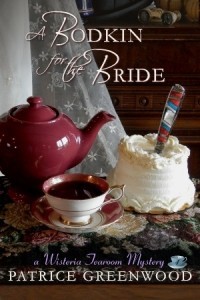
A Bodkin for the Bride by Patrice Greenwood
Yet there you go. I plan to pick up both of these, though most likely I will not read Wells’ book till I’ve got time for a break, which, sheesh, the way this year is stacking up, could be a while. I’ll read Greenwood’s right away because I’m familiar with that world right now.
Anyway, also:
Technically there’s no rush to read this third book in Django Wexler’s Thousand Names series, because I’m almost sure he said there would be a forth book to tie the series up. But I’ll probably read this one without waiting.
What else have I missed that’s just come out or is due out this month?

Five things fantasy authors could learn from Dorothy Dunnett
Via tor.com, a post by Marie Brennan about, as you can see from the title, things epic fantasy authors could learn from Dorothy Dunnett.
Well, yeah. Talk about epic.
Marie Brennan points out how well Dunnett used omniscient pov, and what a good choice that was for her epic historicals.
The benefit this offers to an epic fantasy writer can be demonstrated any time Dunnett has to discuss the larger board on which her pieces are moving. She can, with a few elegantly-written paragraphs, remind the reader of the political and military forces moving in France, Spain, England and Scotland—and she can do it actively, with lines like this one:
“Charles of Spain, Holy Roman Emperor, fending off Islam at Prague and Lutherism in Germany and forcing recoil from the long, sticky fingers at the Vatican, cast a considering glance at heretic England.”
The plain expository version of that would be a good deal more dull, robbed of personality and movement, because it could not show you what the Holy Roman Emperor was doing: it could only tell you. To liven it up, the writer of third limited would need to make her characters have a conversation about Spanish politics, or else jump to a character who’s in a position to see such things on the ground. And that latter choice offers two pitfalls of its own: either the character in question is a nonentity, transparently employed only to get this information across, or he gets built up into a character worth following… which rapidly leads you down the primrose path of plot sprawl. (I was a longtime fan of the Wheel of Time; I know whereof I speak.)
Which is true. Although Brennan then points out the REALLY interesting thing Dunnett was doing with pov, which is: she never (fine, almost never) showed Lymond’s pov, even though he is actually the protagonist. It was the first time I had ever seen someone make a character into the primary protagonist without also making him into a pov character. The reader always sees Lymond from the outside. This allows Dunnett to conceal his motivations and thoughts from the reader as well as from the other characters. It is a technique that works extremely well.
It impressed the hell out of me, let me tell you.
I tried using that technique myself later, in fact, but that work, a long duology or maybe a trilogy, wasn’t picked up for publication. As I recall, two different editors said something on the close order of: “This is beautiful, but it’s too innovative and we don’t know if it will sell.” I have always suspected that redacting the protagonists pov probably contributed to why they felt that way. Marie Brennan’s comment on the technique is: “I wouldn’t recommend trying this nowadays; your editor would probably think you’ve lost your mind.” Why, yes, I think she could be right.
However, eventually that work will find a home or else I will self-publish it. It’s still one of my personal favorites, so leaving it in a drawer forever is not the plan. But, no rush. I have lots of other stuff coming out in the next few years.
Anyway, if you, like me, love Dunnett, you should click through and read the whole thing. If you haven’t actually tried the Lymond chronicles, well, I highly recommend ’em, but do go on past the second book. The first stands alone and is excellent by itself, but the second always felt like mere filler to me. Then the ball really gets rolling and I wouldn’t say any of the other books stand alone, so plan to go straight through to the end.
Also!
Why do you suppose Marie Brennan didn’t mention Phillipa as one of her important and impressive female characters? Because Phillipa is so young when she and Lymond first meet? I actually thought her development through the series was handled very well and quite believably. She’s a great favorite of mine — though of course I love Kate, too, and Sybilla. If you’ve read the Lymond chronicles, how did you feel about Phillipa? And about the way the romance subplot worked out through the course of the books?

June 30, 2015
Whoosh, there went half the year
I’m seeing a lot of top-ten lists for the first half of 2015. For example, here’s Random Musings. Yes, yes, I do mean to get to I’ll Meet You There and Bone Gap eventually. Brandy’s reviews were persuasive.
Then here’s Maureen’s list from BySingingLight. By an amazing coincidence, there’s Bone Gap and Uprooted again. Really, I do mean to try Bone Gap one of these days.
Here’s Chachic’s list, and lo! Uprooted and Once Upon a Rose. Also, I’m happy to see Pure Magic made Chachic’s list.
There’s lots more. Talk about a popular topic. Here’s Bibliotropic’s list, and here are the Book Smugglers. I like the way Ana and Thea separate their lists into published-this-year vs published-whenever, because I do hate to see earlier books fade to black on lists of this kind. Ana and Thea both have Uprooted, again — I’m guessing Ria might not have read Uprooted yet, because man, it is EVERYWHERE.
Including my list, yes.
You can sure see which months I’m working seriously on something and which months I’m not. I read 13 books in January, 11 in February, and 1 in March. That’s when I was finishing the House of Shadows sequel, Door Into Light.
Then I read 12 books in April, but was busy in May, preparing to bring out the Black Dog Short Stories and Pure Magic. Oh, and also working on the photo album for my parents’ Golden Wedding Anniversary, so only 2 books in May. Then 9 so far in June because even though I’m working on The White Road of the Moon, I had quite a lot of time where I was too distracted to do anything useful, but not so very distracted that I couldn’t read. Hours a day to pour into reading! July will be a dead month for reading fiction, I’m pretty sure.
So that’s a mere 38 books so far this year, which is dreadful. DREADFUL. But some of them have been excellent, so there’s that.
January favorites: Eight Days of Luke by DWJ and The Shadow Throne by Django Wexler.
February favorites: Ancillary Sword by Ann Leckie, Cuckoo Song by Frances Hardinge, Once Upon a Rose by Laura Florand. Wow, that’s eclectic.
March favorite: I only read one book in March, but on the other hand, I did enjoy it very much. It was Vision in Silver by Anne Bishop.
April favorite: is there any question? Tracker by CJC.
In May, I only read two books and neither was good enough to count as a favorite.
June favorites: The Golden Age trilogy was a favorite by the time I got to the third book, mostly because wow, the setting is so fabulous. Also, YES, FINE, Uprooted was definitely a favorite and I’m sure it will be one of my top reads for 2015. And . . . to my surprise . . . An Aria of Omens makes the list, squeaking in just under the wire for June.
I even wonder if my mother might like this series, and usually she sticks to old-fashioned mysteries — Rex Stout, Ngaio Marsh, you know. She doesn’t care for modern mysteries, but I think this might appeal to her more than most because of the protagonist’s somewhat old-fashioned sensibilities and language. My mother would appreciate the Miss Manners references, too. In fact, now that I think of it, it would be great if Patrice Greenwood would start actually having Ellen *quote* Miss Manners. You all have read some of Miss Manners’ columns, right? Because they’re hilarious. Accurate, too.
Anyway! Those are my picks for 2015 so far. That’s nearly a quarter of all the books I’ve read this year! Ah, every year I seem to read fewer books. I still have a lot to do this year after finishing White Road, too. Maybe next year I can take something of a break and kind of catch up.
How about you all? Any titles that have particularly stood out for you so far?
And, if you haven’t read Uprooted yet, have you got it on your TBR list?

John Boorman’s Lord of the Rings
I got this from Mike S. via Google+
I don’t know anything about John Boorman, but I feel like I do after reading this comment at the link, where we get a summary of Boorman’s proposed screenplay, posted by a commenter named geoffrey, to whom I am sure we’re all grateful because our lives would not be complete without the following:
The Lord of the Rings:
John Boorman’s LSD Hippy Version
From the beginning of the screenplay to about the 15-minute mark:
We first see J. R. R. Tolkien in his study, then we find ourselves right by the active volcano of Mount Doom! The camera starts panning away, showing the rocky terrain of Mordor. Back, back, and then we see what can only be called the Great Wall of Mordor. For the most part the Great Wall is natural, but where necessary artificial walls and towers have completed it.
Then we hear a chorus of voices (children and old men) chanting the old familiar “Three Rings for the Elven Kings under the sky…” Etc.
Then we see, right beside Mount Doom, the Tower of Sauron, complete with Eye.
We swoop away from Mordor over the Pelennor Fields to the city of Minas Tirith. Swoosh! Then we’re swept over the Misty Mountains, into Forest Fangorn, then to the Great River, catching a glimpse of Theoden’s castle. We zip by other castles with convoluted shapes to the crystalline palace of Rivendell. Then…
We’re at the Shire. It’s Bilbo’s 111th birthday party! He’s giving his farewell speech, and he obviously doesn’t want to leave the Shire. Gandalf has to pressure him to go. There is no “magic Ring” moment.
Gandalf takes Bilbo to the latter’s cottage (that’s right: cottage), and Gandalf tells Bilbo to go to Rivendell. After a verbal struggle, Bilbo drops the Ring into Gandalf’s hat and goes down the road towards Rivendell.
Later that same night Frodo comes to the cottage he inherited from Bilbo. Gandalf is still there. Gandalf tells Frodo to take the Ring, and he bids Frodo try it on. Frodo is psychologically unable to do so. Frodo, in a trance, mutters, “One…to rule…them…In the Land of Mordor…where the Shadows lie.” This shocks Gandalf.
Frodo then tries to give Gandalf the Ring, but Gandalf sternly forbids Frodo to tempt him with the Ring.
BANG! The door swings open. In come Sam, Pippin, and the fat Merry. They saw “a dark shape…a black horse…a face without…eyes”. Gandalf jumps up and tells Frodo to celebrate his inheritance by taking his three friends on a holiday to Rivendell.
As the sun rises, the four Hobbits leave for Rivendell as Gandalf tells Frodo, “And remember, don’t put it on – unless you have to.”
On this spring day the Hobbits merrily walk through an apple orchard full of swirling apple blossoms. Then they come to a field of mushrooms, which they pick and eat as fast as they can. They start giggling and laughing, and their feet become unsteady. They lurch into a field of buttercups, naked children running amidst the flowers. Then the four Hobbits run past a flock of sheep, and then past fifty scarecrows with nasty faces.
Later, when the Hobbits come across some men, one of the latter says, “Halfling? Where? There’s a reward if you catch one of them.” Frodo mocks them and eludes them by putting on the Ring, accidentally stepping in a cowpie.
Later, the Hobbits see a Rider coming down the road. They hide in the hedge. The Rider stops, does his sniffing thing, then rides off. The Hobbits continue their journey, but now they avoid the road.
And here we come to the end of the movie’s first 15 minutes.
As can be seen, this screenplay wastes little time. The four Hobbits all leave within hours of Bilbo leaving, going to the same place. One wonders why the four Hobbits don’t catch-up with the 111-year-old Bilbo.
The “high on mushrooms” thing is very 1970 (when this script was written).
Also interesting is Gandalf telling Frodo it’s OK to use the Ring if he needs to. Plus the lack of any doubt on Gandalf’s part about the Ring. No throwing it in the fireplace, or writing on the Ring, or etc. No history lesson. Just: Take your Ring and go to Rivendell!
Geoffrey provides more of the summary of the screenplay as you scroll down. I highly recommend you click through and enjoy (?) the whole thing.


